White-tailed Deer
There are two species of deer in the vicinity of the Lake: mule and white-tailed. Mule deer are common to much of British Columbia, while (the tawny northwestern subspecies of) white-tailed deer, while common to much of North America, are only found in the provincial interior, and primarily here in southeast. The white-tailed deer favours the valley bottoms and so is generally found alongside the Lake in the forests or on the beach. The mule deer is more often to be found in the high country.
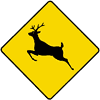 A frequent roadside sign in the vicinity of the Lake. Its antlers, bound, and tail hint that it might represent a white-tailed deer.
A frequent roadside sign in the vicinity of the Lake. Its antlers, bound, and tail hint that it might represent a white-tailed deer.
The white-tailed deer gets its name from the underside of its tail which is seen when the tail is raised in distress; the topside of the tail, shown when the tail is down, is the same tawny colour as the back of the animal. The animal also has white buttocks. The points on the antlers of the buck all arise from a forward curving main beam. The running gate of the white-tailed deer is characterized by a rocking motion as it swings its hind feet ahead of the front ones. In the summer, the coat of the deer is tawny, while in the winter it turns greyish. There are examples of each in the images below.
There is extensive evidence of deer around the Lake: hoof prints in sand or snow; scat, gnawed bits of foliage (deer prefer to browse, but will graze). For the longest time, I couldn’t figure out how to get frequent pictures, but that problem having been addressed, this page is now well populated with images. As a way of illustrating the abundance of the White-tailed Deer in the vicinity of the lakeshore, I note that all of the images below were taken within an area of about a hectare along the West Arm.
There are other pictures and a movie of white–tailed deer on the page about local Apple Raiders.
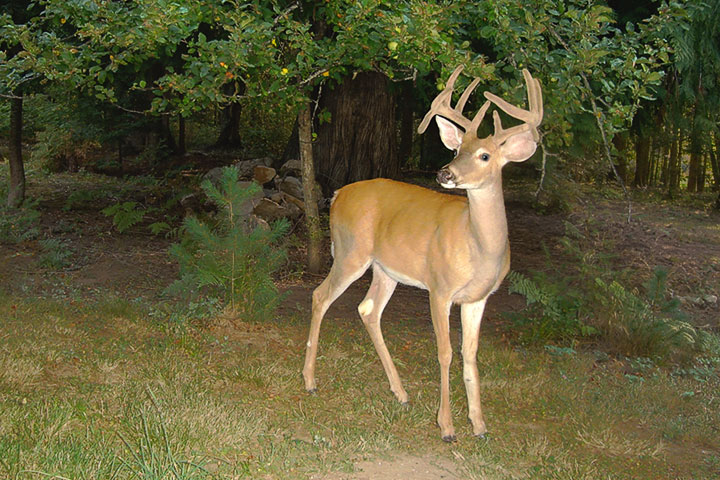
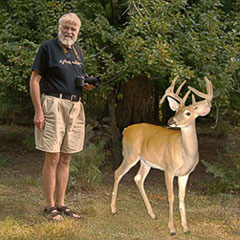 It is mid August and this buck has been visiting the apple tree. Its antlers are still in velvet and growing.
It is mid August and this buck has been visiting the apple tree. Its antlers are still in velvet and growing.
The insert picture (right) is a properly scaled composite of the main picture and one with a human; it was made merely to illustrate the size of the deer.
This buck is about 90 cm tall at the shoulder—a typical height. (The two pictures were taken from the same place with the same camera and then combined).
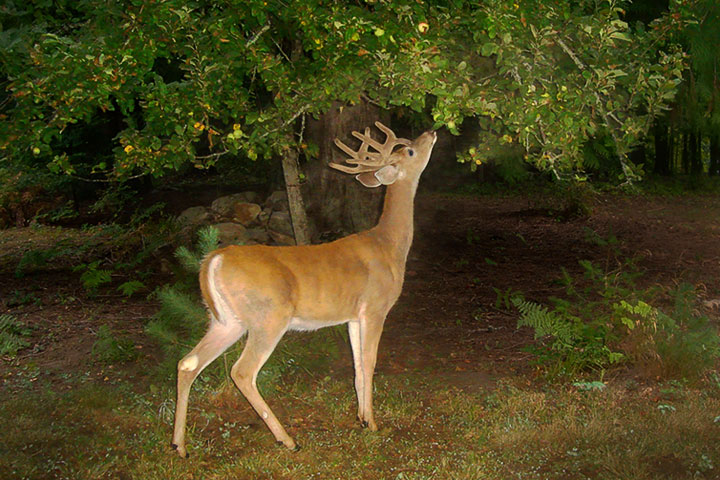 Bears are not the only surreptitious visitors to the apple tree in August.
Bears are not the only surreptitious visitors to the apple tree in August.
 It is March, and this doe still wears the greyish coat of the winter.
It is March, and this doe still wears the greyish coat of the winter.
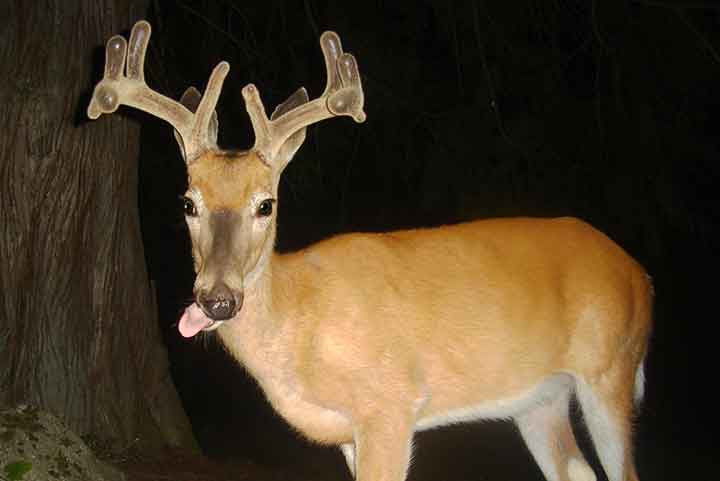 It is early July, and the growth of this White-tailed Buck’s velvet-covered antlers is well underway. The buck was foraging in the forest close to the lakeshore at night. The extended tongue adds a touch of insolence to his grandeur.
It is early July, and the growth of this White-tailed Buck’s velvet-covered antlers is well underway. The buck was foraging in the forest close to the lakeshore at night. The extended tongue adds a touch of insolence to his grandeur.
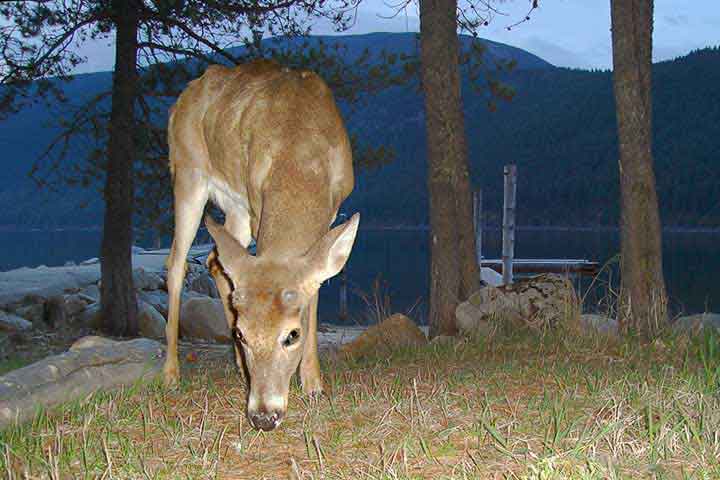 This mid–April shot of a male White–tailed Deer shows the beginning of antler growth.
This mid–April shot of a male White–tailed Deer shows the beginning of antler growth.
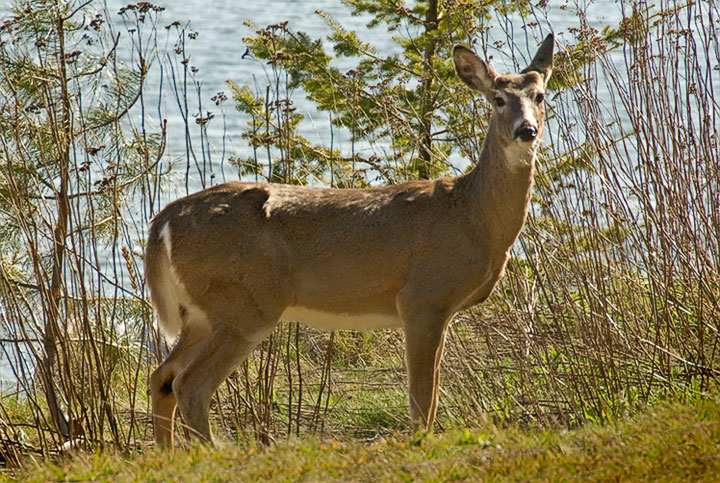 This late April view of a buck along the lakeshore shows the forehead bumps heralding the beginning of antler growth.
This late April view of a buck along the lakeshore shows the forehead bumps heralding the beginning of antler growth.
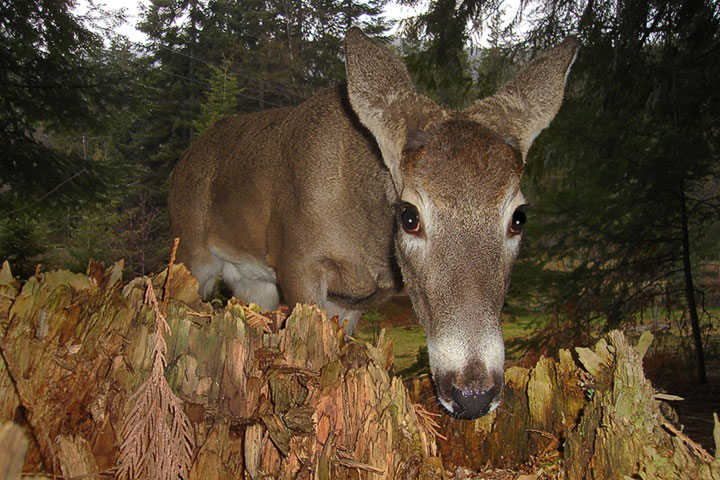 Despite the closeness of the deer, it was unaware of the camera. Look at its ears; they are turned to detect predators from behind.
Despite the closeness of the deer, it was unaware of the camera. Look at its ears; they are turned to detect predators from behind.
It is early April and this deer is wearing a greyish coat.
 The White-tailed Deer is named for the underside of its tail, which is raised as a flag when the animal takes off. The raised tail does not seem to serve as an alarm (other deer seem to ignore it), but as a statement to predators that they have been spotted and there is no point in chasing such a fast animal.
The White-tailed Deer is named for the underside of its tail, which is raised as a flag when the animal takes off. The raised tail does not seem to serve as an alarm (other deer seem to ignore it), but as a statement to predators that they have been spotted and there is no point in chasing such a fast animal.
This picture shows both the tawny top of the tail when down and the white underside when up.
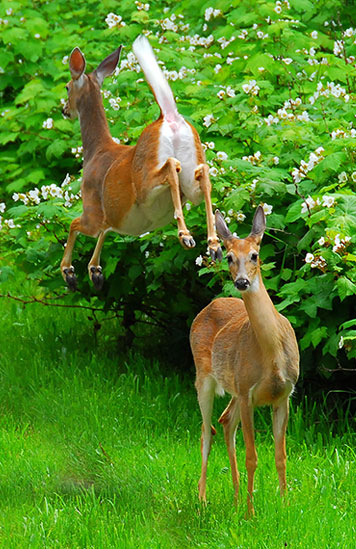 The White-tailed Deer is remarkable for the elevation to which it can jump. Rather than going around its companion, this deer went over.
The White-tailed Deer is remarkable for the elevation to which it can jump. Rather than going around its companion, this deer went over.
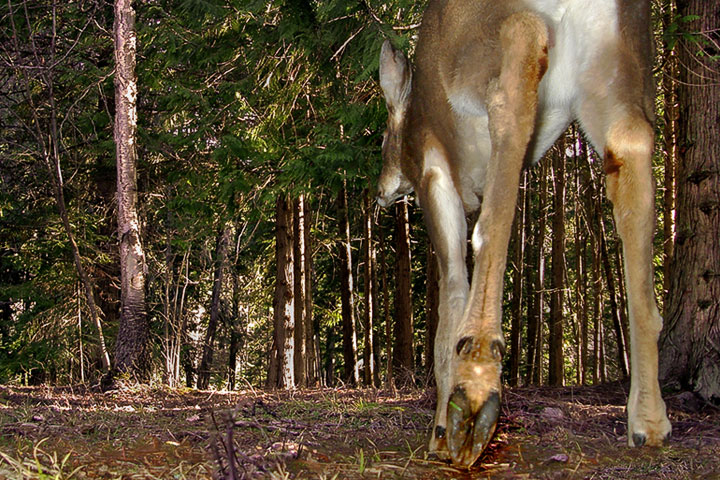 This deer walking through the forest lifts its hind leg to reveal its hoof: it is cloven, and heart-shaped; behind and slightly above it are two small appendages called dewclaws.
This deer walking through the forest lifts its hind leg to reveal its hoof: it is cloven, and heart-shaped; behind and slightly above it are two small appendages called dewclaws.
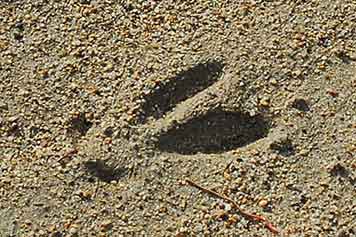 This hoof print from a White-tailed Deer shows two toes and dewclaws. The deer is travelling to the right; the two toes are spread; the two indentations from the dewclaws are the dots to the left.
This hoof print from a White-tailed Deer shows two toes and dewclaws. The deer is travelling to the right; the two toes are spread; the two indentations from the dewclaws are the dots to the left.
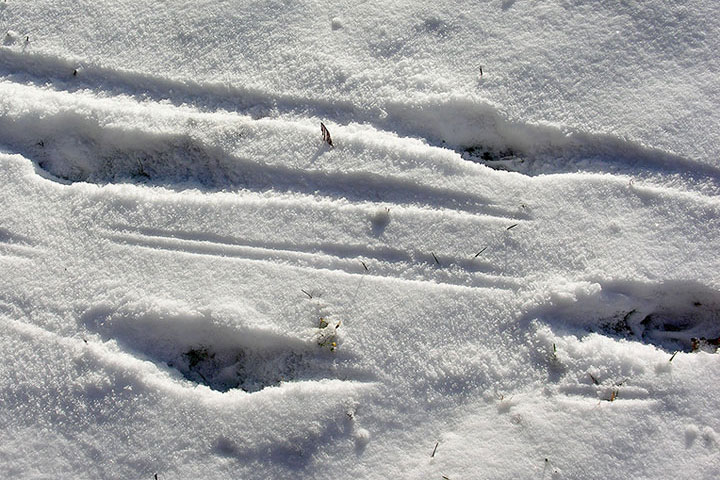 The White-tailed deer walked across shallow snow from right to left, and dragged its hooves. It may well be a buck (male), which are more likely to drag their front legs owing to the considerable weight of their antlers, but does (females) are known to leave such tracks also.
The White-tailed deer walked across shallow snow from right to left, and dragged its hooves. It may well be a buck (male), which are more likely to drag their front legs owing to the considerable weight of their antlers, but does (females) are known to leave such tracks also.
 Before posing for a portrait, these doe had probably been browsing on the thimbleberry bushes.
Before posing for a portrait, these doe had probably been browsing on the thimbleberry bushes.
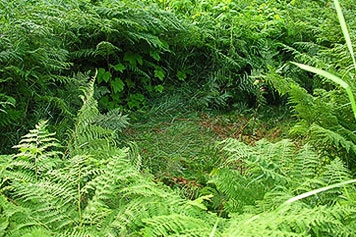 Deer have beaten down a bed amidst the ferns. I have seen a whitetail doe and its fawn in the vicinity; it is likely their bed.
Deer have beaten down a bed amidst the ferns. I have seen a whitetail doe and its fawn in the vicinity; it is likely their bed.
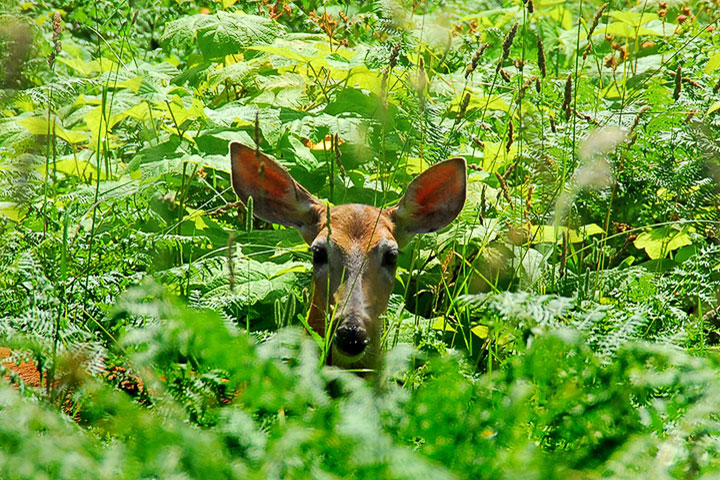 This doe hides in the thick brush during the day. If it hadn’t poked its head up to take a peek, I wouldn’t have known it was there.
This doe hides in the thick brush during the day. If it hadn’t poked its head up to take a peek, I wouldn’t have known it was there.
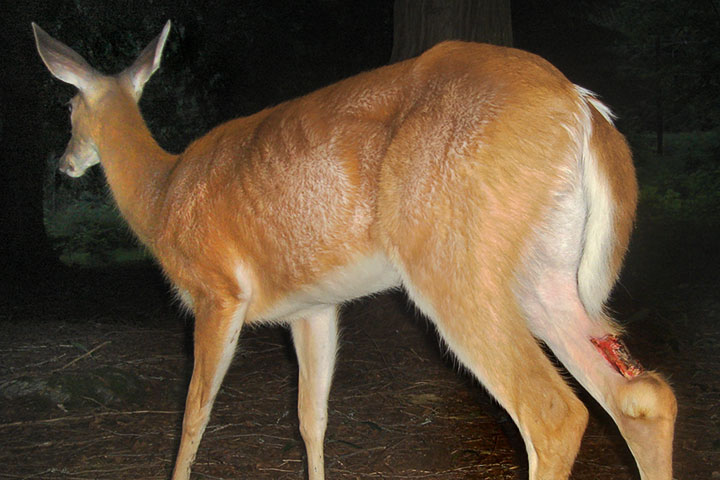 One evening this white-tailed doe came by with its fawn. Two nights later, the fawn was missing and the deer was moving uneasily as a result of a bite just above the hock or tarsal joint of its right hind leg. I have not seen the fawn since.
One evening this white-tailed doe came by with its fawn. Two nights later, the fawn was missing and the deer was moving uneasily as a result of a bite just above the hock or tarsal joint of its right hind leg. I have not seen the fawn since.
 Deer like to browse on the leaves of cedar trees and in doing so, can do considerable damage, but only up to the top of their reach: the brouse line. This cedar hedge has a browse line at a height of about 1.7 meters, above which the hedge is healthy
Deer like to browse on the leaves of cedar trees and in doing so, can do considerable damage, but only up to the top of their reach: the brouse line. This cedar hedge has a browse line at a height of about 1.7 meters, above which the hedge is healthy
 In one end, out the other. The ground in front of the browsed cedar shows many piles of deer scat.
In one end, out the other. The ground in front of the browsed cedar shows many piles of deer scat.
 This doe has lifted its hind leg so as to scratch its head and in doing so, reveals a swollen udder.
This doe has lifted its hind leg so as to scratch its head and in doing so, reveals a swollen udder.
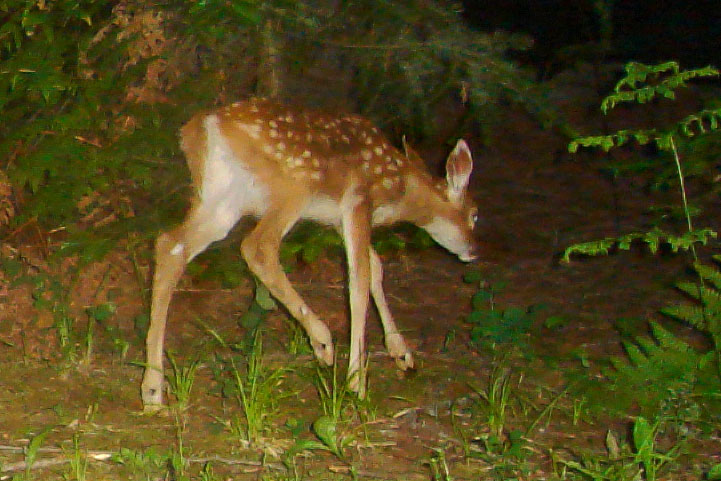 It is late June and this fawn is out foraging in the evening with its mother.
It is late June and this fawn is out foraging in the evening with its mother.
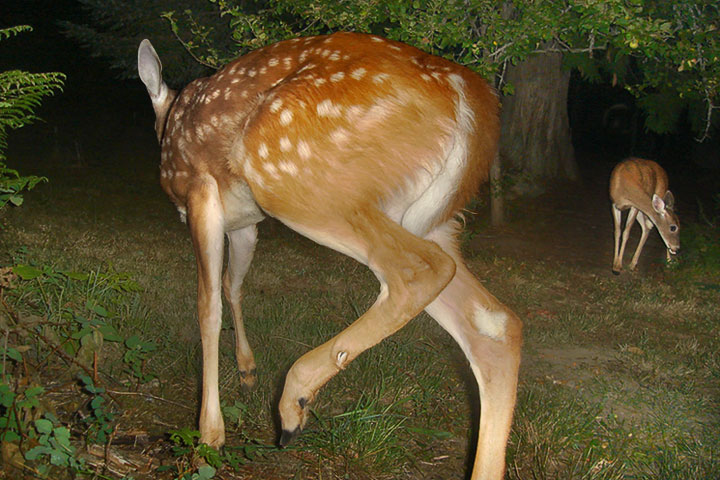 It is the end of August and this fawn still wears its spots and forages with its mother.
It is the end of August and this fawn still wears its spots and forages with its mother.
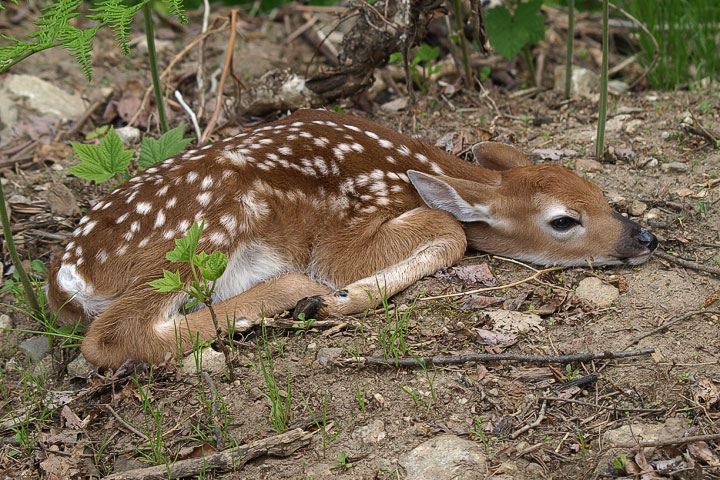 When a fawn is encountered, it lies perfectly still in the hope that it will not be noticed.
When a fawn is encountered, it lies perfectly still in the hope that it will not be noticed. Doug Thorburn
Doug Thorburn
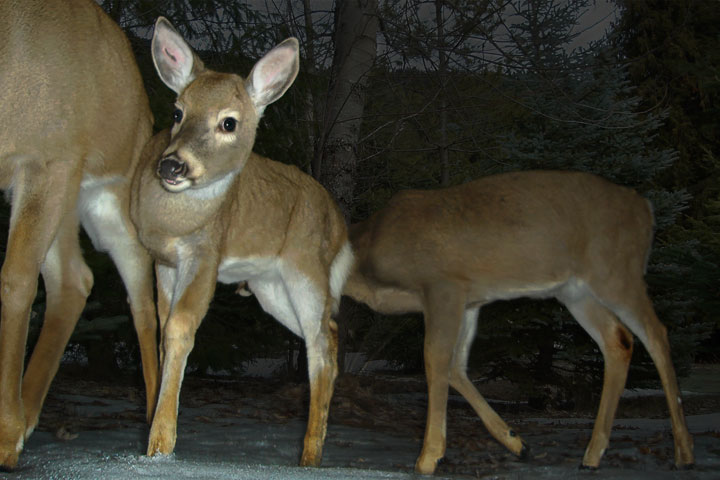 It is early February, but this fawn foraging with is mother still seems rather small.
It is early February, but this fawn foraging with is mother still seems rather small.
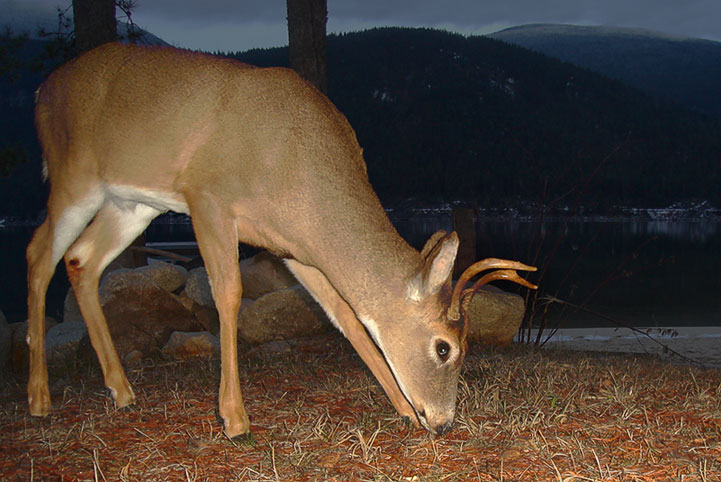 White-tailed yearling In its first full year (between first and second birthdays) a buck’s antlers are but single spikes or simple forks. It is December and this yearling, grazing by the lakeside, has lost its velvet.
White-tailed yearling In its first full year (between first and second birthdays) a buck’s antlers are but single spikes or simple forks. It is December and this yearling, grazing by the lakeside, has lost its velvet.
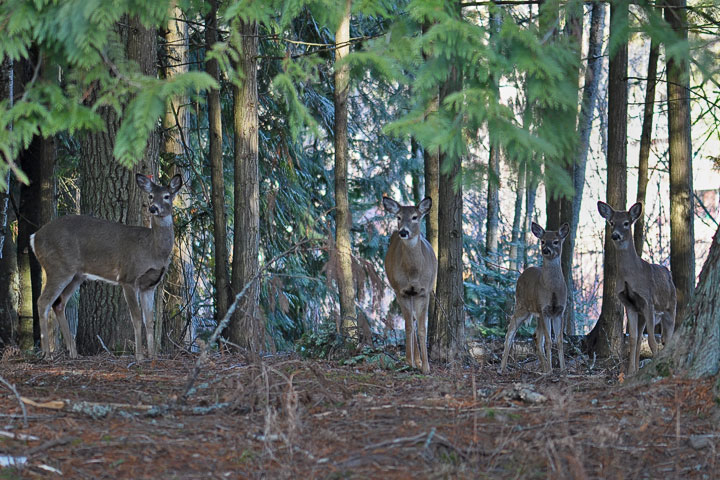 I went for a walk behind my house one the afternoon and discovered that I was being watched.
I went for a walk behind my house one the afternoon and discovered that I was being watched.
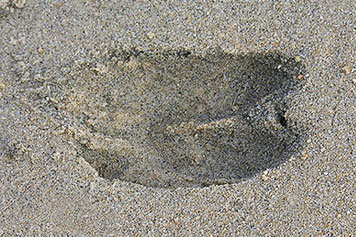 A Deer’s hoof print in wet sand. Prints of the front and back hooves are superimposed; the dewclaws did not register.
A Deer’s hoof print in wet sand. Prints of the front and back hooves are superimposed; the dewclaws did not register.
 Deer often wander the forests beside the Lake in small groups. There are two doe in the foreground, and beyond some trees on the right, two bucks.
Deer often wander the forests beside the Lake in small groups. There are two doe in the foreground, and beyond some trees on the right, two bucks.
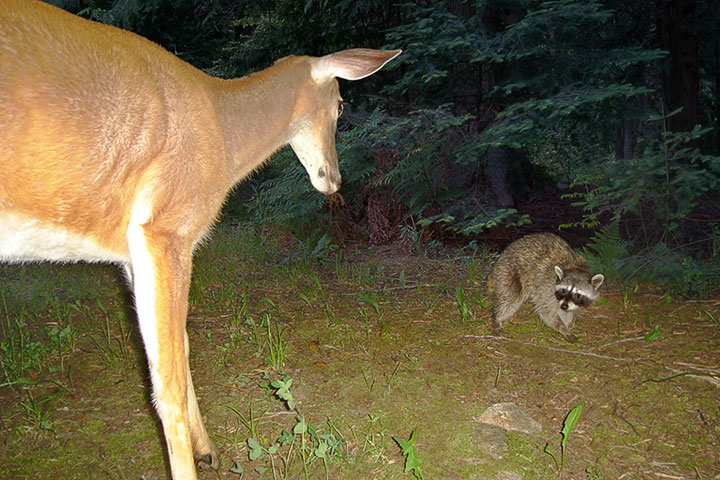 An encounter such as this between nocturnal animals must be fairly common. It is less common to capture an image of it. In this warm summer’s evening meeting between a white-tailed doe and a raccoon, it was the raccoon which withdrew.
An encounter such as this between nocturnal animals must be fairly common. It is less common to capture an image of it. In this warm summer’s evening meeting between a white-tailed doe and a raccoon, it was the raccoon which withdrew.
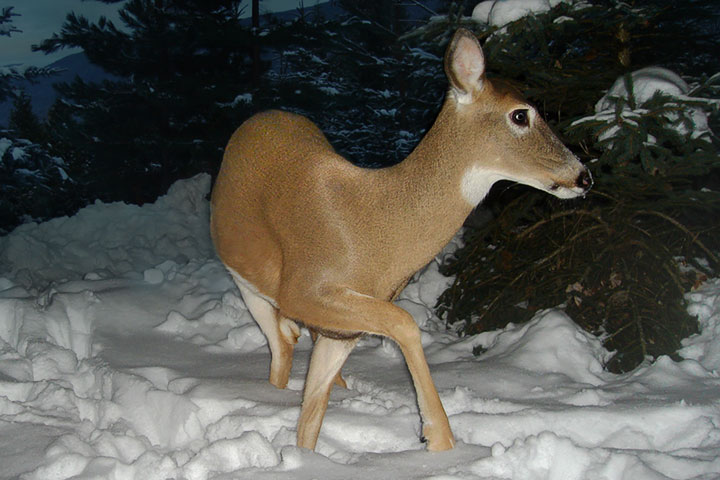 As the snow gets deeper, this doe lifts its legs higher.
As the snow gets deeper, this doe lifts its legs higher.
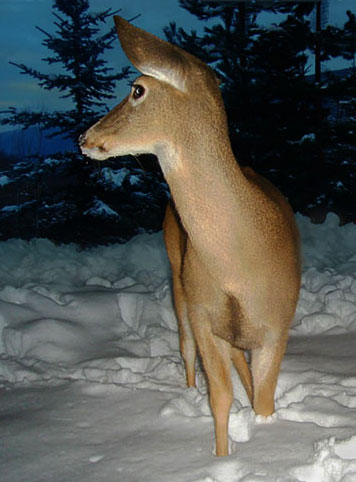 Constantly on alert, a doe looks back along its path for predators.
Constantly on alert, a doe looks back along its path for predators.
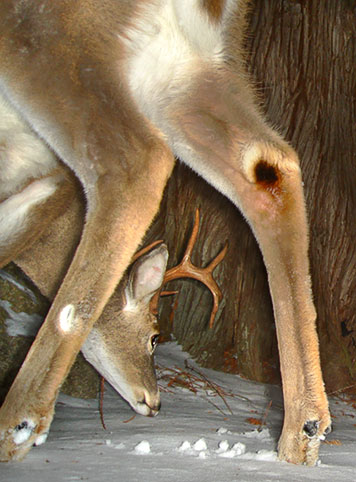 It is the end of December and this buck foraging in the forest still has his antlers.
It is the end of December and this buck foraging in the forest still has his antlers.
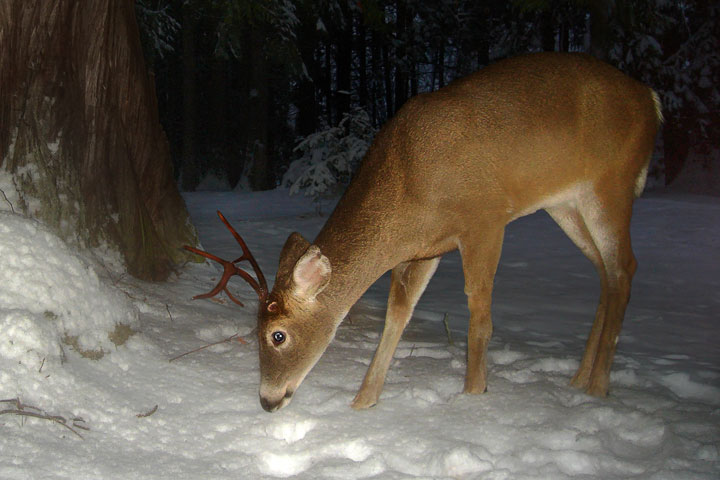
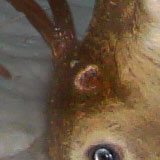 It is early January. Four days ago, when this buck last came by, it had two antlers—but, now, only one. There is a circular scar (insert) on the left side of its head where that antler used to attach. White–tailed bucks usually drop their antlers in January.
It is early January. Four days ago, when this buck last came by, it had two antlers—but, now, only one. There is a circular scar (insert) on the left side of its head where that antler used to attach. White–tailed bucks usually drop their antlers in January.
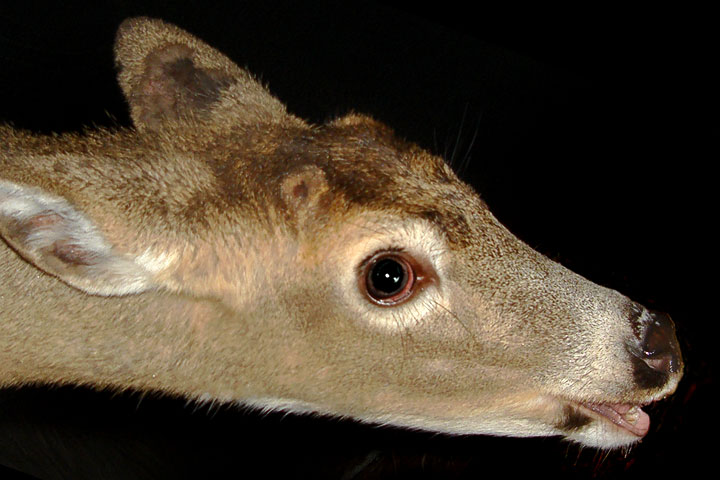 The easiest way to tell the males from the females in the winter is by looking for antler scars—the round marks on the buck’s forehead.
The easiest way to tell the males from the females in the winter is by looking for antler scars—the round marks on the buck’s forehead.
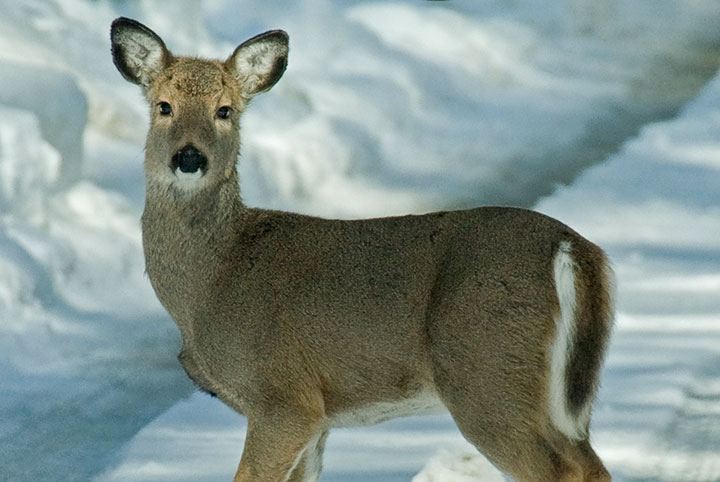 The first reaction of a deer when it perceives danger is to freeze—maybe it won’t be noticed. When the deer is on a highway, this habit is unfortunate. Elsewhere, the photographer is presented with a few precious moments for a portrait.
The first reaction of a deer when it perceives danger is to freeze—maybe it won’t be noticed. When the deer is on a highway, this habit is unfortunate. Elsewhere, the photographer is presented with a few precious moments for a portrait.
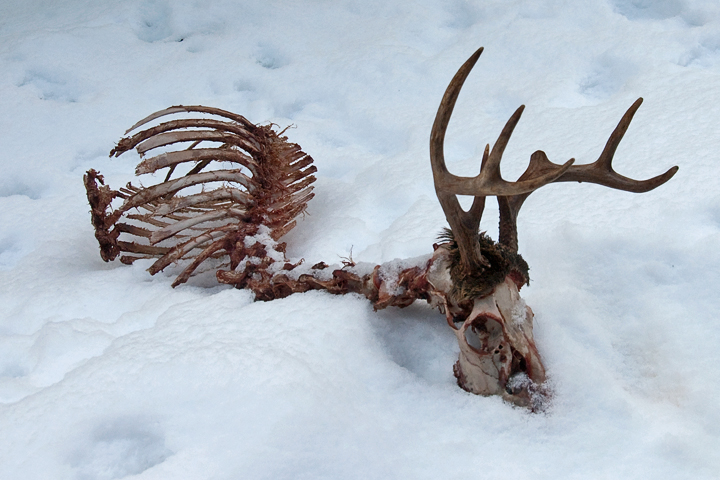 Not every deer survives the winter. This skeleton of a white–tailed buck was found in February snows.
Not every deer survives the winter. This skeleton of a white–tailed buck was found in February snows.
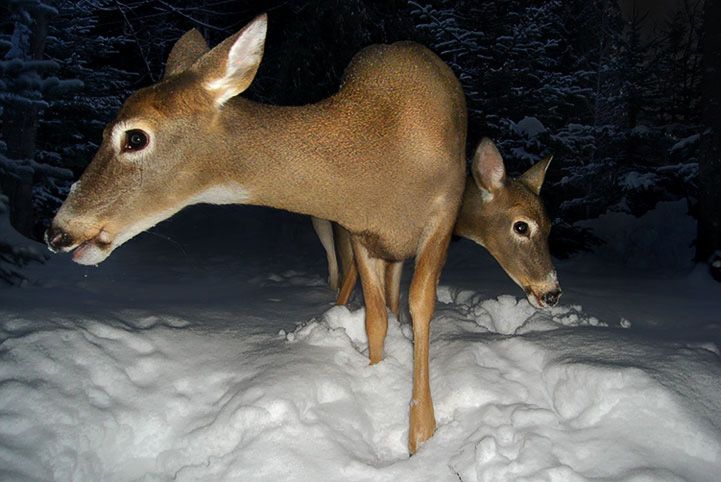 Does often forage together; more often bucks are seen alone.
Does often forage together; more often bucks are seen alone.
Information from BC Ministry of the Environment: White-tailed Deer in BC; from Hinterland Who's Who: White-tailed Deer.
![]()